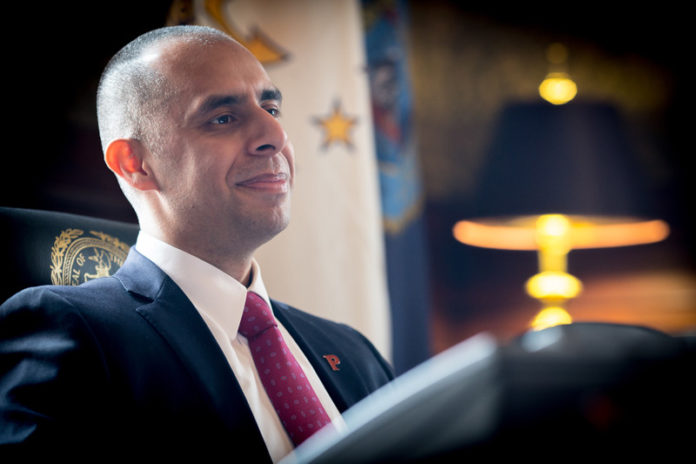
PROVIDENCE – Providence Mayor Jorge O. Elorza is looking to increase school spending and freeze city taxes as part of his proposed fiscal 2018 budget.
The third-year mayor on Wednesday introduced his budget to City Council, including an overall spending increase of 2.3 percent to $734.3 million compared with fiscal 2017.
Education was a central focus of the mayor’s new budget, which must be approved by City Council.
“There is no better contribution we can make to our society than to support the education of our children,” Elorza said during a speech to council members.
Elorza proposes to increase the city’s contribution to the Providence Public School District by $3.6 million, bringing the city’s total contribution to $128.5 million. The year-over-year increase would mark the first time more money went from the city to the schools in seven years.
“We recognize that in order to close the achievement gap, we need to support our students from the cradle to career,” Elorza said.
The school district receives an additional $255.3 million from the state that passes through the city’s budget. Together, with the city’s contribution, schools receive 51.5 percent of the entire city budget.
Elorza’s budget includes $4.1 million earmarked for various education-related programs, including $1 million for “Providence for Youth: Summer Jobs,” a program that would increase summer employment opportunities for students by 40 percent. Nearly $1 million more would go toward five new recreation camps.
“These collective investments in our children, along with the continued involvement of our community partners are designed to make a statement: Providence is all in for youth and education,” Elorza said.
The proposed budget does not include any new spending for economic-development initiatives, but Elorza pointed to various development projects in the city, saying it’s happening, regardless. He hopes the trend continues and gave credit to the state’s economic-development efforts to lure big-name companies to Rhode Island.
“We want businesses to know that there is no company too small, whether it is a staff of three or 3,000, we want you here in Providence,” he said.
The budget keeps residential property tax rates level at $18.80 per $1,000 in value for owner-occupied homes and $32 for landlords. The commercial rate would hold steady at $36.7.
City Council President Luis A. Aponte, who said he wants to more closely vet the budget before making any broad statements, was glad to see the tax freeze.
“Our residents are already heavily taxed, so that was a welcomed sign,” Aponte told Providence Business News. “I am a little concerned, however, with the revenue at the state, which has fallen short. Usually, when that happens the state resolves its problems by cutting down to city and towns.”
State revenue was $43 million lower than forecasted through the first nine months of the fiscal year, according to March estimates.
The city estimates it will receive about $74 million in state aid, which could, of course, be revised depending on how the state determines its fiscal 2018 budget.
At the same time, the city is also increasing spending in public-safety initiatives, including a new “municipal ID” program. Elorza wants to spend $150,000 for a request for information and startup costs for the creation and issuance of Providence IDs.
City officials say the IDs have been used in other cities, including Detroit and New York, and are used by various groups, including undocumented workers and members of the LGBTQ community who want to self-identify gender and sexual orientation.
The city is also spending more than $2 million across this and next fiscal years on a police academy and two new firefighter academies. The city also expects a small boost in new revenue from red-light cameras in school zones. The cameras are designed to take license-plate photos of speeding cars and send speeding tickets to owners by mail.
The city expects to pay off its cumulative deficit, and put 1 percent of its budget (excluding school appropriation) – or $3.5 million – toward a rainy day fund for the first time in four years.
Long-term obligations related to pensions and other post-employment benefits, including health care, continued to drag down the city’s balance sheet. The city this year decreased its assumed rate of return by 0.25 of a percentage point, to 8 percent, which increased annual contributions by $2 million. And while the new assumed rate of return gives the city a better picture of long-term unfunded liabilities, it’s still 0.5 percentage points greater than the state’s assumed rate of 7.5 percent, which it could lower this year. Last fiscal year, the city’s unfunded liabilities for pension and OPEBs neared $2 billion.
Finally, the city is looking again to make an investment in infrastructure, which became a hot-button issue dividing Elorza and the City Council last year. City voters approved a $40 million bond referendum earmarked for city infrastructure, including roadways and sidewalks, but the city couldn’t agree on a spending plan, resulting in no action.
As part of his budget, Elorza presented a Capital Improvement Plan, which city officials say is a stepping stone toward a renewed effort.
Aponte says he’s open to discussions and noted the need for infrastructure improvements.
“It’s no secret to anyone that we have deferred regular maintenance,” he said. “There’s a will on the council to move forward, as long as there’s … a sense of confidence that it will be equitable across neighborhoods.”
Elorza, in closing, told councilors he’s optimistic about the city’s future.
“Providence is on the rise and we’re uniquely positioned to be one of America’s great cities,” he said.
Correction: An earlier version of this story misstated the residential and commercial property tax rates.











